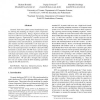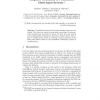20 search results - page 1 / 4 » The How and Why of Interactive Markov Chains |
FMCO
2009
Springer
13 years 2 months ago
2009
Springer
This paper reviews the model of interactive Markov chains (IMCs, for short), an extension of labelled transition systems with exponentially delayed transitions. We show that IMCs a...
CIKM
2006
Springer
13 years 8 months ago
2006
Springer
We propose a method for discovering the dependency relationships between the topics of documents shared in social networks using the latent social interactions, attempting to answ...
DSN
2007
IEEE
13 years 10 months ago
2007
IEEE
Dynamic Fault Trees (DFT) extend standard fault trees by allowing the modeling of complex system components’ behaviors and interactions. Being a high level model and easy to use...
ATVA
2007
Springer
13 years 10 months ago
2007
Springer
Abstract. Dynamic fault trees (DFTs) are a versatile and common formalism to model and analyze the reliability of computer-based systems. This paper presents a formal semantics of ...
BIRTHDAY
2008
Springer
13 years 6 months ago
2008
Springer
Abstract. Probabilistic systems of interacting intelligent agents are considered. They have two sources of uncertainty: uncertainty of communication channels and uncertainty of act...


